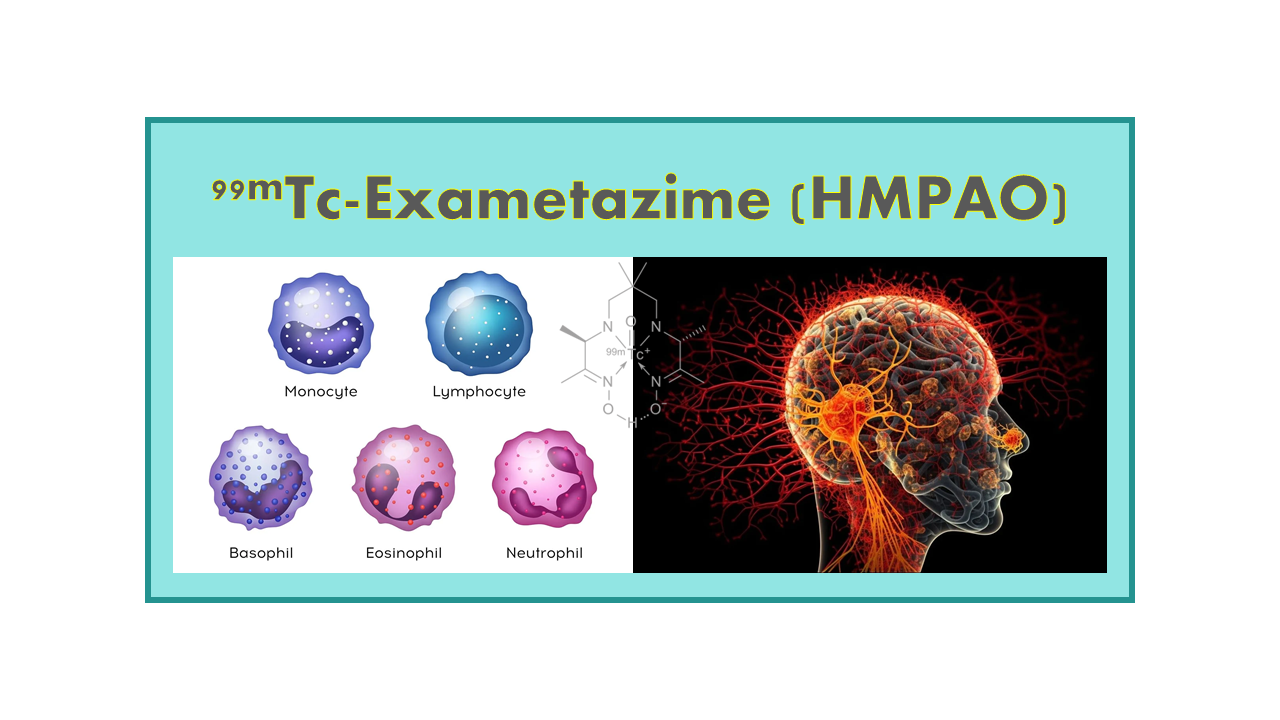
99mTc-Exametazime (HMPAO)
April 6, 2024
99mTc-Exametazime (HMPAO) is a radiopharmaceutical used in nuclear medicine for various diagnostic imaging purposes. It is commonly used for imaging the central nervous system (CNS) to detect vascular abnormalities, inflammation, and infections.
Here are some key points about 99mTc-Exametazime (HMPAO):
- Radiopharmaceutical: 99mTc-Exametazime is a radiopharmaceutical that contains the radioisotope technetium-99m. This radioisotope emits gamma rays that can be detected by imaging devices such as gamma cameras.
- Leukocyte Labeling: One of the primary uses of 99mTc-Exametazime is for leukocyte labeling. This involves tagging white blood cells with the radiopharmaceutical to detect areas of inflammation or infection in the body.
- CNS Imaging: In CNS imaging, 99mTc-Exametazime is used to visualize blood flow in the brain, detect abnormalities in cerebral perfusion, and localize areas of inflammation or infection.
- Procedure: During imaging with 99mTc-Exametazime, the radiopharmaceutical is injected into the patient’s bloodstream. The gamma camera then captures images of the distribution of the tracer in the body, allowing healthcare providers to assess the target area.
- Half-life: Technetium-99m has a relatively short half-life of about 6 hours, which allows for imaging procedures to be conducted efficiently without prolonged radiation exposure to the patient.
- Safety: 99mTc-Exametazime is considered safe for clinical use when administered in appropriate doses and under the supervision of trained healthcare professionals. The radiation exposure associated with this tracer is minimal and generally well-tolerated by patients.
Overall, 99mTc-Exametazime (HMPAO) plays a crucial role in the diagnosis and management of various CNS conditions, particularly in the detection of inflammation, infection, and vascular abnormalities. Its ability to target specific areas of interest through leukocyte labeling makes it a valuable tool in nuclear medicine imaging.
Description
99mTc-Exametazime (99mTc-hexamethylpropylene amine oxime, 99mTc-HMPAO) is a generic tracer used in CNS vascular imaging and the detection of inflammation or infection (leukocyte labeling).
Clinical applications
Brain imaging: 99mTc-Exametazime is used as an adjunct in the diagnostic study of cerebrovascular disease (acute stroke, transient ischemic attack). These cerebral perfusion studies are useful to confirm the presence of cerebral infarction, monitor the effects of acute thrombolytic therapy, and to predict stroke outcome. Sensitivity in detecting acute ischemia is higher than CT if imaging is performed within the first 24 h. Doses used per patient are in the range of 10–15 mCi.
Leukocyte labeling: HMPAO can be used to label leukocytes for scintigraphy in the localization of intra-abdominal infection and inflammatory bowel disease (dose about 5 mCi). Leukocytes taken from a blood sample are labeled ex vivo and reinjected to the patient for imaging. It can be used in general cases of diffic.0.ult to diagnose infectious or inflammatory diseases (FUO, osteomyelitis, suspicion of prosthesis infection).
Availability
In the US and Europe this tracer is available from GE Healthcare under the brand names Ceretec® and Cerestab® (marketed since 1988). Other generic forms of HMPAO are available from DiaMed (Teoxim, Russian MA 1998), Medi-Radiopharma (Medi- Exametazime / Tc-MR-14, Brain-SPECT / Tc-MR-5, Leuco-Scint / Tc-MR-6).
In August 2017, Jubilant Life Sciences received USFDA approval for Drax Exametazime. This approved new drug application is indicated for leukocyte (white blood cell) labeled scintigraphy as an adjunct in the localization of intra-abdominal infection and inflammatory bowel disease.
In 2013, in Europe, a fully reconstituted dose of 99mTc-Exametazime did cost between EUR 300 and 450 (US$ 330-500) per patient. In 2020 in the USA, a dose of Exametazime is charged around US$ 1,650
Competition
99mTc-Bicisate / ECD (Neurolite, Lantheus) was also brought on the market for cerebral perfusion, but it seems that in certain cases Exametazime shows still some advantage. IMP (Iofetamine) can also be a substitute to HMPAO or ECD in certain cases.
For inflammation/infection Scintimun can also be prescribed since 2010.
Comments
HMPAO is an old generic tracer that has been extensively explored and is used often by practitioners because it has this long history. However, the new tracers that came onto the market in the meantime are more specific and will probably replace HMPAO in the future.